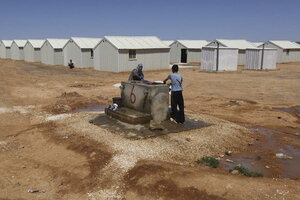UN hopes its second Syrian refugee camp in Jordan gets it right
Jordan opened Azraq, a second UN-run Syrian refugee camp, this week, rejiggering everything from food choices to toilet location based on three years of trial and error at Zaatari.

New Syrian refugees wash clothes at the Azraq Syrian Refugee camp near Al Azraq, Jordan, April 30, 2014. The new camp is divided into 12 villages with a holding capacity of 5 to 15,000 people per village.
Muhammad Hamed/Reuters
AZRAQ, JORDAN
In a remote, windswept corner of Jordan’s eastern desert, a new city is springing up, one that aims to avoid the mistakes of its precursor 60 kilometers to the east.
This week the United Nations and Jordan's government opened Azraq, Jordan's latest refugee camp for Syrians. When filled, as it almost certainly will be, it will hold 130,000 people, surpassing the existing camp in Zaatari, currently the world's second-largest refugee camp and Jordan's fourth largest city.
The area around Azraq is desolate. The featureless plain makes even the desert scrub of Zaatari seem lush. But the harsh surroundings belie a carefully planned camp that incorporates lessons learned from two years of running Zaatari, which initially struggled with overcrowding, poor services, violence, and organized crime.
“We have learned a lot from our mistakes,” said Jordan’s interior minister, Hussein Majali, at the camp’s opening ceremony Wednesday.
Zaatari was built virtually overnight, and the aid agencies were unprepared for the flood of refugees they received. In those early days, families felt the need to fend for themselves, and would tear apart public facilities to improve their own living conditions, says Andrew Harper, the country head of the UN refugee agency, UNHCR. There were riots, which were often blamed on Syrian regime provocateurs, but poor services, tensions between Syrian refugees and Jordanian police, and the generally chaotic atmosphere also played a role.
UNHCR has spent 13 months and about $63 million setting up Azraq, in the hope they can avoid a repeat of the same problems. Mr. Harper calls it “one of the best planned refugee camps in the world.”
Home improvements
Zaatari’s inhabitants were first housed in tents that offered little protection against the extreme desert climate, then moved into expensive prefabricated trailers – an ongoing process that has been a constant source of tension in the camp. Families arriving in Azraq are being housed in purpose-built shelters that are larger than those in Zaatari, better suited suitable to the local climate, and considerably less expensive.
Where Zaatari provided communal kitchens and bathrooms, which were destroyed by refugees in order to build their own, Azraq has given every few shelters their own bathrooms and shower stalls. Each family also gets its own cooking stove. Shelters are arranged in small clusters of six, rather than along long, nameless streets. Officials hope the new arrivals will settle alongside friends and relatives, building communities and quickly taking ownership of the camp.
Food distribution, too, is being done differently. In Zaatari, refugees were given food parcels, which they often sold so they could buy other food items, such as dairy products. Azraq will be the first refugee camp in the world to use vouchers from day one, says Jonathan Campbell, head of the World Food Programme in Jordan.
The camp has a huge supermarket where refugees can spend UN-provided coupons, as well as their own cash, to buy a wide variety of foodstuffs. The system is not only more efficient, but offers refugees a sense of dignity and self-determination, Mr. Campell says.
Persistent challenges
But despite the hindsight and planning, some of the same problems still materialized as the first refugees arrived this week.
“There is no electricity,” says Khaled, a refugee from Homs who had just arrived in Jordan with his wife and five children, sounding exhausted and angry. “Electricity is a necessity and there is no life without it.”
Electricity was a key problem at Zaatari. The predominantly middle-class refugees were used to getting their news from television, entertaining their children with cartoons, and communicating with their families via cell phone. This wasn't provided, but refugees figured out how to pirate power from camp facilities and sell it on the black market. UNHCR has been unable to shut this down, and has ended up footing the bill at a cost of up to $700,000 a month.
Another problem is the sheer size of Azraq. Refugees may have to walk long distances just to reach basic services like the hospital and the market.
“The water is so far away,” says Khaled. “We have to walk 2 kilometers if we want to go to the supermarket, 2 kilometers in the heat of this summer.”
Eventually, the UN hopes to build some kind of public transportation system. Officials also talk of using solar power to meet the camp’s basic demands. But the UN has raised less than 20 percent of the funds needed to keep basic operations running through 2014, so such improvements are low priority.
Sitting on the supermarket steps after buying food for his family, Khaled echoed a common complaint sentiment among the displaced.
“I want to go back to Syria. If the conditions stay like this I’d rather go back to the shelling."

